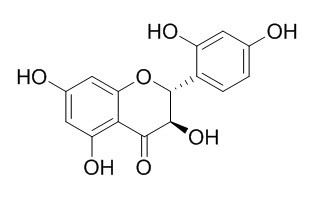Dihydromorin
trans-Dihydromorin is an effective hypopigmenting agent in normal skin cells, hypopigmenting agents effective in melanoma system may not be effective on normal melanocytes, indicating that a non-tumor melanocyte system is more suitable for the screening of hypopigmenting agents. Dihydromorin shows strong mushroom inhibitory activity with IC50 values lower than 50 microM, more potent than (IC50 = 71.6 microM), it may be as an antibrowning agent in food systems.
Inquire / Order:
manager@chemfaces.com
Technical Inquiries:
service@chemfaces.com
Tel:
+86-27-84237783
Fax:
+86-27-84254680
Address:
1 Building, No. 83, CheCheng Rd., Wuhan Economic and Technological Development Zone, Wuhan, Hubei 430056, PRC
Providing storage is as stated on the product vial and the vial is kept tightly sealed, the product can be stored for up to
24 months(2-8C).
Wherever possible, you should prepare and use solutions on the same day. However, if you need to make up stock solutions in advance, we recommend that you store the solution as aliquots in tightly sealed vials at -20C. Generally, these will be useable for up to two weeks. Before use, and prior to opening the vial we recommend that you allow your product to equilibrate to room temperature for at least 1 hour.
Need more advice on solubility, usage and handling? Please email to: service@chemfaces.com
The packaging of the product may have turned upside down during transportation, resulting in the natural compounds adhering to the neck or cap of the vial. take the vial out of its packaging and gently shake to let the compounds fall to the bottom of the vial. for liquid products, centrifuge at 200-500 RPM to gather the liquid at the bottom of the vial. try to avoid loss or contamination during handling.
Front Pharmacol.2021, 12:761922.
J of Liquid Chromatography & Related Technologies2024, 47(1-5):14-25.
Molecules.2024, 29(16):3976.
Br J Pharmacol.2018, 175(6):902-923
Molecules.2024, 29(11):2626.
Phytochemistry Letters2017, 449-455
Natural Product Communications2020, doi: 10.1177.
Food Chemistry: X2023, 101032.
J Food Compos Anal2017, 62:197-204
J Microbiol Biotechnol.2023, 33(10):1317-1328.
Related and Featured Products
J. Funct. Foods, 2015,13:375-83.
Oxyresveratrol and trans -dihydromorin from the twigs of Cudrania tricuspidata as hypopigmenting agents against melanogenesis[Reference:
WebLink]
The depigmenting effects of oxyresveratrol and trans- Dihydromorin were investigated in b16F10 cell line and its synergetic melan-a cells, as well as in 3-dimensional skin models.
METHODS AND RESULTS:
But their inhibitory effects were different in two cell lines. In b16 cells, oxyresveratrol showed stronger depigmenting effect than trans- Dihydromorin, with greater suppression on tyrosinase activity. Both of them induced post-transcriptional degradations of microphthalmia-associated transcription factor (MITF), leading to significant decreases of tyrosinase related protein 1 (TRP-1) and tyrosinase related protein 2 (TRP-2) production. In melan-a cells, trans- Dihydromorin exhibited stronger inhibition on melanin synthesis. It also induced greater suppression on the levels of tyrosinase, TRP-1 and TRP-2 via MITF down-regulation at both transcription and translation level. Evaluations in artificial skin model also demonstrated the depigmenting effects of trans- Dihydromorin.
CONCLUSIONS:
In conclusion, we found that trans -Dihydromorin is an effective hypopigmenting agent in normal skin cells. Furthermore we demonstrated that hypopigmenting agents effective in melanoma system may not be effective on normal melanocytes, indicating that a non-tumor melanocyte system is more suitable for the screening of hypopigmenting agents.
Mol. Nutr. Food Res., 2008,52(12):1530-8.
Isolation of tyrosinase inhibitors from Artocarpus heterophyllus and use of its extract as antibrowning agent.[Pubmed:
18683821]
A new furanoflavone, 7-(2,4-dihydroxyphenyl)-4-hydroxy-2-(2-hydroxy propan-2-yl)-2, 3-dihydrofuro(3, 2-g)chromen-5-one (artocarpfuranol, 1), together with 14 known compounds, Dihydromorin (2), steppogenin (3), norartocarpetin (4), artocarpanone (5), artocarpesin (6), artocarpin (7), cycloartocarpin (8), cycloartocarpesin (9), artocarpetin (10), brosimone I (11), cudraflavone B (12), carpachromene (13), isoartocarpesin (14), and cyanomaclurin (15) were isolated from the wood of Artocarpus heterophyllus.
METHODS AND RESULTS:
Their structures were identified by interpretation of MS,( 1)H-NMR,( 13)C-NMR, HMQC, and HMBC spectroscopic data. Among them, compounds 1-6 and 14 showed strong mushroom tyrosinase inhibitory activity with IC(50) values lower than 50 microM, more potent than kojic acid (IC(50) = 71.6 microM), a well-known tyrosinase inhibitor. In addition, extract of A. heterophyllus was evaluated for its antibrowning effect on fresh-cut apple slices. It was discovered that fresh-cut apple slices treated by dipping in solution of 0.03 or 0.05% of A. heterophyllus extract with 0.5% ascorbic acid did not undergo any substantial browning reaction after storage at room temperature for 24 h. The antibrowning effect was significantly better than samples treated with the extract (0.03 or 0.05%) or ascorbic acid (0.5%) alone.
CONCLUSIONS:
The results provide preliminary evidence supporting the potential of this natural extract as antibrowning agent in food systems.
J. Nat. Prod., 2002, 65 (2), pp 163–169
Constituents of the Bark and Twigs of Artocarpus dadah with Cyclooxygenase Inhibitory Activity[Reference:
WebLink]
Fractionation of an ethyl acetate-soluble extract of the bark of Artocarpus dadah has led to the isolation of three new prenylated stilbenoid derivatives, 3-(γ,γ-dimethylallyl)resveratrol (1), 5-(γ,γ-dimethylallyl)oxyresveratrol (2), 3-(2,3-dihydroxy-3-methylbutyl)resveratrol (3), and a new benzofuran derivative, 3-(γ,γ-dimethylpropenyl)moracin M (4), along with six known compounds, oxyresveratrol, (+)-catechin, afzelechin-3-O-α-l-rhamnopyranoside, (−)-epiafzelechin, Dihydromorin, and epiafzelechin-(4β→8)-epicatechin.



